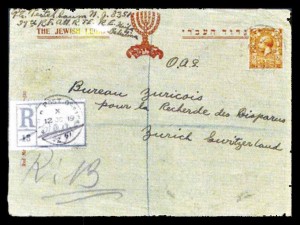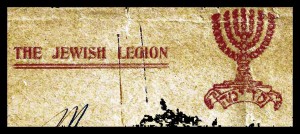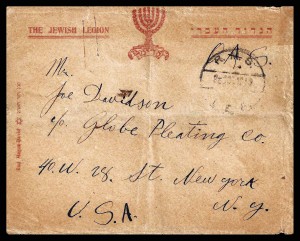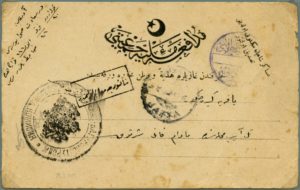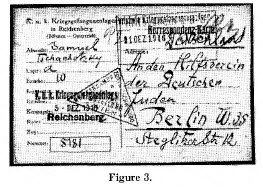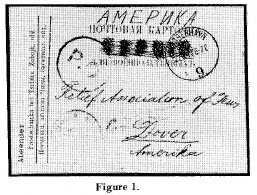WORLD WAR I
Our FOCUS is ONLY on the HOLYLAND (PALESTINE)
POSTAL OFFICES
T
T
Jewish Connection
T
(1) Jewish Legion (Part of Allies Powers)
(2) Turkish Jews (Part of Ottoman Military Post Offices)
(3) Jewish POW’s
T
T
(1)
Jewish Legion (Part of Allies Powers)
T
MEMORIES OF THE JEWISH LEGION 1917 – 1920 Identifying Markings On Mail
A Generation Ago
collecting covers bearing the markings of the Jewish Legion was a respected niche area in Palestine Philately. F. W. Pollack, editor of the Holy Land Philatelist gave article space to the history and legends of the Legion. He also promoted items available in postal auctions, which he sponsored. Time effaces all things and this area has passed from view. With the recent relocation of the San Diego Philatelic Library and the culling of excess material from the Israel holdings, these gems have come to light again.
Legion Background
Of especial interest are the lands of origin of the men who joined the Jewish Legion and the wide variety of mail, which they generated. Jabotinsky’s call for volunteers for an all–Jewish fighting force evoked an enormous response spanning four continents.
The units that did see service in Palestine, Jordan, Syria, and Egypt were largely composed of men from the United Kingdom, Canada, the United States, Argentine and Brazil, as well as a near company–strength unit of Turkish Jews
released from a POW facility in Egypt. Enormous numbers from other nations volunteered: 1600 from Salonika, over 2000 from Italy, and a deputation from the mountain Jews of Dagestan in the Caucasus..
Even though the Legion was dissolved in 1919, intact units were reassigned to other military formations and continued in service till 1920. Several units guarded various mail trains.
Legion Post Cards
The card in Figure 1 is from the January 2008 issue of Israel philatelic magazine the Shovel (p. 13) and includes two of the three known distinguishing features for the Legion: the Menorah inscribed “Kadima” (Forward) along its base and the hand stamp in English capitals: “The Jewish Legion.” The sender, N. J. Teitelbaum, identifies his unit as the 39th Battalion, Royal Fusiliers, one of the three battalions to which Legionnaires were assigned by the British Army.
Two other interesting features to note. It is addressed in French for delivery by the Swiss authorities while the destination is inscribed in English for the convenience of the postal authorities in Palestine. The recipient was an arm of the International Red Cross, which carried the burden of amassing and dispensing information on the missing in action during the Great War, World War I.
The Figure 2 post card is from the Michael Bass collection and displays the Menorah insignia. It bears the rare R.M.S.I.E.F. cancellation of Railroad Mail Service Indian Expeditionary Forces. There is an OAS (On Active Service written by the cancel so it went postage free to the United States.
This last item is found in the Holy Land Philatelist (p. 1245) and is a picture post card with a map of Palestine on the reverse. (Editor’s note: The card could not be copied to picture here.) The obverse contains an imprinted insignia with Hebrew inscription in bold lettering meaning “Headquarters of the Hebrew Command”; the three Jewish battalions of the Royal Fusiliers had adopted this insignia. On the card the spelling of Palastine is quite unique, with what seems like an umlaut over the second “a” in “Palästai(e)n.
References:
1. . . . . . January 2008, p. 13.
2. . . . . . “The Jewish Battalions,” Holy Land Philatelist, No. 60/61, October/November 1959, Vol. V/VI, p. 1244.
. . . . December 2013,The Israel Philatelist, Vol LXIV, no. 6 pp. 236 – 237.
Figure 1
Menorah inscribed “Kadima” (Forward)
Hand stamp “The Jewish Legion”
Figure 2
(2)
Turkish Jews
(Part of Ottoman Military Post Offices)
Jewish soldiers in the Ottoman Army
With the outbreak of Word War I, two different concepts of the Jewish role in the world conflict emerged among Zionists. The majority of the Zionist movement leaders tended to keep a pro-German line, mostly aimed against Russia and hoping to defeat the Czarist anti-Semitic policies. The supporters of the alliance between England and France were in a minority. With the abolition of the capitulations, the Turks offered the Jewish population the choice of either accepting Ottoman citizenship or leaving the country. From 1916, Jewish settlers were forced to enlist. Most Jews aged 28 to 45 were called up to join the Ottoman army. Many were imprisoned; others, among them Ben-Zvi and Ben-Gurion, were deported. Of the 18,000 Jewish deportees and refugees, some 12,000 landed in Alexandria, Egypt and later became the basis for the Jewish Legion.
Several thousand Jewish residents of Palestine were inducted into the Turkish army; a few of them were trained and appointed as officers, engineers, doctors and interpreters. Among them was Moshe Shertok (Sharett) who was a law student at Istanbul University. He returned to Tel Aviv and became a member of the Ottoman movement. In 1916, he joined the Ottoman army, completed an officers course and, being fluent in Turkish, German and Arabic, served as a translator on the Macedonian and South-Trans-Jordanian frontlines. Sharett would later become the first Foreign Minister of the State of Israel and its second Prime Minister.
http://www.alexandercollection.org/collectionitem.aspx#collection=165&overview=1
Shertok M. postcard from the Macedonian front to Tel Aviv 1917
Description
Postcard sent from the Macedonian front by cadet officer Moshe Shertok (Foreign Minister of the State of Israel in 1948) to his family in Jaffa, message dated 22.1.1917. Shertok served as an interpreter to a German officer in the 146th Infantry Regiment, 46th Division, 20th Army Corps. At right “146th Regiment cachet” in violet, at left double circle cachet of the Bulgarian – Turkish join censor commission & Istanbul framed censor cachet. Upon arrival in Jaffa the postcard was cancelled by “Jaffa” postmark.
Date
22/1/1917
Markings
“146th Regiment cachet” in violet
Bulgarian – Turkish join censor commission double circle cachet
Istanbul framed censor cachet Istanbul framed censor cachet
“Jaffa” postmark (Collins PM18)
Place of Origin
Macedonia
Place Through (transit)
Istanbul
Place of destination
Tel Aviv Jaffa
Object Type
Postcard
Object Type
Postcard
Reg.Number
MHDA.0935.2012
Glossary
Censored Mail
http://www.alexandercollection.org/collectionitem.aspx#collection=165&item=690243902&startitem=11
(3)
Jewish POW’s
POW’s mail
During World War I, about 8 million men surrendered and were held in POW camps until the war ended. All nations pledged to follow the Hague rules on fair treatment of prisoners of war, and in general the POWs had a much higher survival rate than their peers who were not captured. The German Empire held 2.5 million prisoners; Russia held 2.9 million, and Britain and France held about 720,000. The US held 48,000. The most dangerous moment was the act of surrender, when helpless soldiers were sometimes shot down. Once prisoners reached a POW camp conditions were better, thanks in part to the efforts of the International Red Cross and inspections by neutral nations.
POW mail was usually sent free of charge, generally under the auspices of the International or local Red Cross or Red Crescent committees, although this service depended on the country of origin. Sometimes airmail and other services were available to POWs at the regular rates in effect at the time of posting. More often, POWs were provided with forms, cards or other items of stationery, the use of which was compulsory.
On December 13, 1918 the armistice was extended and the Allies reported that by 9 December, 264,000 prisoners had been repatriated.
http://alexandercollection.org/collectionitem.aspx#collection=592525267&overview=1
Figure 3
But for Jewish PW s there was a special address as well, the Hilfsverein der Deutschen Juden (the Aid Society of German Jews), headquartered in Berlin and widely-known as the major Jewish aid group in pre-war Europe. Aaron Michelsohn, in a PW camp near Delegyhaza, Hungary; Yankel Kaplan, in
Langensalza, Germany, and Samuel Tschachotzky, in Reichenberg, Bohemia
(Austria) were among the many PWs who tried to communicate with their families in Russia and Russian-Poland through the Hilfsverein. Figure 3, Tschachotzky’s card, a pre-printed Reichenberg PW Camp card (upper left) has a dated Reichenberg stamp of Dec. 5, 1916, and the triangular Vienna censorship cancel lower L, and upper R, both a ” Post agefree PW Mail” and – less visible – the receiving stamp of the Hilfsverein, dated Dec. 21, 1916.
Israel Philatelist 1991 Volume 42 Issue 7-8 Page 19 (6271) JEWISH PWs IN WORLD WAR I, Part 1: Loyalty — A Matter of Geography, Figure 3.
Figure 1
There were some 50 camps on the Asiatic side of the Urals, according to the
“Handbuch der Kreigsgefangenenpost Tsingtau” (Published in German in
Dusseldorf, 1964), to which I am grateful for considerable background information. And through the early part of 1917, it would appear that mail from these camps was s till being routed westward. Such mail to Austria often shows only the camp censors’ marking, and the triangular Vienna stamp found on incoming as well as outgoing mail.
But mail to t.he U.S. was taking a more roundabout route. A July 1917 card from a Hungarian Jewish officer PW, asking for a loan of 100 rubles, to be repaid when he returned to Debrecen, went via neutral Denmark. Figure 1 shows a pre-printed Pieschanka camp card, with a Moscow censors’ stamp, Copenhagen transit cancel, the circled P.C. of the American censor, and the standard “No charge for postage, Prisoner of War Mail, New York, N.Y.”
Israel Philatelist 1991 Volume 42 Issue 9 -10 Page 24 (6321) JEWISH PWs IN WORLD WAR I, Part 2: The Repatriation of the “Galicians”

